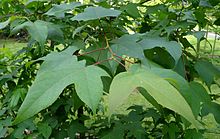Liquidambar acalycina
| Liquidambar acalycina | |
|---|---|
 |
|
| Scientific classification | |
| Kingdom: | Plantae |
| Clade: | Angiosperms |
| Clade: | Eudicots |
| Order: | Saxifragales |
| Family: | Altingiaceae |
| Genus: | Liquidambar |
| Species: | L. acalycina |
| Binomial name | |
|
Liquidambar acalycina H.T. Chang |
|
Liquidambar acalycina, Chang’s sweet gum, is a species of flowering plant in the family Altingiaceae (formerly Hamameliaceae), native to southern China. Growing to 30–50 ft (9.1–15.2 m) tall by 20–30 ft (6.1–9.1 m) broad, It is a medium-sized deciduous tree with three-lobed maple-like leaves that turn red in autumn before dropping. It is monoecious, meaning that both male and female flowers appear on the same plant. The flowers are insignificant, yellow/green in colour, and are followed by small gum-balls that persist on the tree until winter. The wood exudes a sweet-smelling resin when pierced, giving the tree its common name.
Liquidambar acalycina is cultivated as an attractive ornamental tree for parks and gardens, and is hardy down to −15 °C (5 °F) or less. It requires cultivation in reliably moist, acid to neutral soil in full sun or partial shade. The cultivar ‘Burgundy Flush’, with leaves opening purple, then green, then burgundy red in autumn, has gained the Royal Horticultural Society’s Award of Garden Merit.
Liquidambar Acalycina is a deciduous tree that has a brown to black colored bark with a conical/pyramidal shape. It matures quickly to be of a medium height ranging at 10m in height, and 6m width. The leaves have three peaks which make the tree similar to that of Maple. However, there are more star shaped than the shape of maple leaves. The leaves start as a burgundy color when they first emerge in the spring but as they grow and mature into summer, they turn into a deep green which indicates their increasing ability to photosynthesize. When nearing fall the colors turn back into a red to purple color. During the months of April to May, monoecious flowers begin to bud with yellow-green colors, but are insignificant for pollination in attracting pollinators. The fruit of this tree is a dark brown black color. This tree serves as a great source of shade for botanical purposes. This Sweetgum Tree prefers soil that is acidic, clay-based, and is in a region with ample sunlight.
...
Wikipedia
